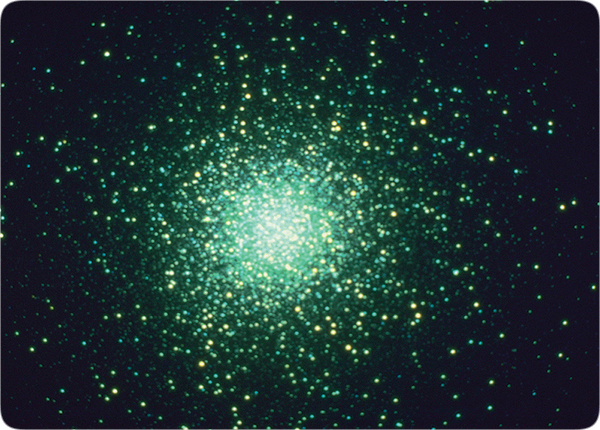Show your support by donating any amount. (Note: We are still technically a for-profit company, so your
contribution is not tax-deductible.)
PayPal Acct:  Feedback:
Feedback: 
Donate to VoyForums (PayPal):
| [ Login ] [ Contact Forum Admin ] [ Main index ] [ Post a new message ] [ Search | Check update time | Archives: 1, 2, [3], 4, 5, 6, 7, 8, 9, 10 ] |
Some stars are found where astronomers agree they could not evolve, near the center of our galaxy. These short-lived stars orbit a massive black hole, where gravity is so strong that gas and dust clouds could never evolve into a star. Instead, the black hole’s massive gravity would pull such clouds (supposedly evolving stars) apart. (e).
Nor could stars have evolved in globular clusters, where up to a million stars occupy a relatively small volume of space.

Figure 200: Globular Cluster. Globular clusters are tight, spherical concentrations of 10,000–1,000,000 stars. This globular cluster, called M13, is about 22,000 light-years away.
Wind and radiation pressure from the first star in the cluster to evolve would have blown away most of the gas needed to form subsequent stars in the cluster (f). In other words, if stars evolved, we should not see globular clusters, yet our galaxy has about 200 globular clusters. To pack so many stars that tightly together requires that they all came into existence at about the same time.
e. “In fact, given our current understanding of how stars form and the properties of the galactic center, it’s [stellar evolution near the galactic center is] not allowed to happen.” Andrea M. Gaze, as quoted by Ron Cowen, “Mystery in the Middle,” Science News, Vol. 163, 21 June 2003, p. 394.
“For example, no one can explain how the stars—which are 15 times heftier than our sun—got there [near the center of our galaxy]. According to most astronomical models, they are too big to have formed in the chaos of the galactic center but appear to be too young to have moved there from farther out.” Robert Irion, “The Milky Way’s Dark, Starving Pit,” Science, Vol. 300, 30 May 2003, p. 1356.
“The bizarre question of the hour is what the young stars are doing there at all. Clouds of gas need a calm and cold setting to collapse into a ball dense enough to ignite nuclear fusion. Yet gravitational tidal forces—from the black hole and from stars in the galaxy’s nucleus—make the galactic center the antithesis of such a [stellar] nursery.” Ibid., p. 1357.
“Ironically, stars such as these have no business being so close to a black hole ... there is no plausible explanation of how and why the hot, young stars near the centre of the Milky Way and Andromeda got there.” Fulvio Melia, “Odd Company,” Nature, Vol. 437, 20 October 2005, p. 1105.
f. “Little is known about the origins of globular clusters, which contain hundreds of thousands of stars in a volume only a few light years across. Radiation pressure and winds from luminous young stars should disperse the star-forming gas and disrupt the formation of the cluster.” J. L. Turner et al., “An Extragalactic Supernebula,” Nature, Vol. 423, 5 June 2003, p. 621.
[From “In the Beginning” by Walt Brown ]
[
Next Thread |
Previous Thread |
Next Message |
Previous Message
]
|
Forum timezone: GMT-8 VF Version: 3.00b, ConfDB: Before posting please read our privacy policy. VoyForums(tm) is a Free Service from Voyager Info-Systems. Copyright © 1998-2019 Voyager Info-Systems. All Rights Reserved. |